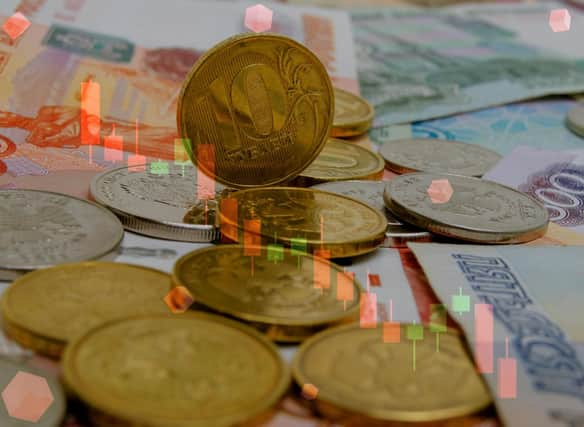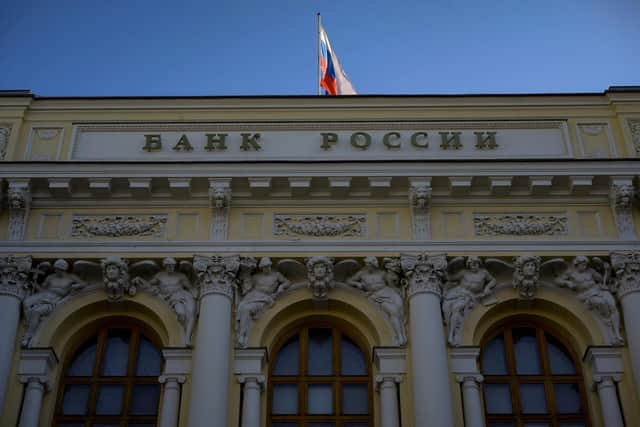Russian ruble: Ruble to pound, dollar, euro today and why Russian ruble’s value is crashing during Ukraine invasion


Russia’s ruble currency has fallen dramatically in value in the weeks since President Vladimir Putin escalated his aggression toward Ukraine.
Since late February, the value of 1 ruble has tumbled from £0.0090 on the pound to lows of £0.0055, with the ruble’s price similarly down on the US and Euro.
Advertisement
Hide AdAdvertisement
Hide AdUK Foreign Secretary Liz Truss and US Secretary of State Antony Blinken appeared at a press conference in Washington D.C on Wednesday (March 9) to declare a united effort to isolating Putin and the Kremlin further, proposing plans to fully ban Russia’s access to the SWIFT messaging network among more economic sanctions.


The impact of sanctions on Russian oil, banks, trade and oligarchs has seen the ruble fall to record lows as Western leaders are poised to declare harsher sanctions after a children's hospital and maternity ward in Mariupol was bombed by Russian forces on Wednesday, according to Volodymyr Zelenskyy.
Here’s why the ruble is crashing and the latest price comparisons between Russia’s ruble and the pound, dollar and euro.
Why is Russia’s ruble crashing?
The ruble began to fall as Russia invaded Ukraine on Thursday February 24, launching strikes by air, land and sea on the country in the early hours of Thursday morning.
An estimated $150 billion (£112bn) in value was wiped off the Moscow Exchange MOEX index in Thursday’s selloff as the Russian index closed 33% lower and equities were down by 50% on their record high in October 2021.
The impact of sanctions from the European Union, UK and United States saw the ruble tumble by approximately 30% last week as Russian banks and companies with Russian operations on foreign stock exchanges bore the brunt of Western allies’ financial measures.
The ruble was trading down by a further 20% in pre-market trading late on Sunday night (February 27) UK time and in the early hours of Monday in Europe, with the ruble crashing to its lowest value to date as markets opened on Monday.
This came after BP confirmed on Sunday that following Russia’s actions and pressure from Western governments it would be relinquishing its 20% stake in Russian state-owned oil conglomerate Rosneft.
Advertisement
Hide AdAdvertisement
Hide AdRussia’s central bank then placed a ban on foreign sales of securities from 4am GMT on the following day.
Infrequent cyber attacks and rushes to pause trading have been taking the Moex exchange offline in the weeks since Russia’s full scale invasion took place – with Russia’s central bank doubling its interest rates from 9.5% to 20% on Monday February 28 to prevent the ruble’s collapse.
How much is the ruble to the British pound today?
As trading opened on Monday morning, the ruble to pound value sharply dropped in line with the Russian currency's expected crash.
1 ruble was worth £0.00090 before trading opened on Monday February 28, crashing to £0.0055 on the following Monday, March 7.
Meanwhile, the ruble’s toppled value has seen £1 in rubles rise by up to 70% on the last month, climbing from roughly ₽140 on February 28 to peak at ₽198 on March 7.
As trading opens on Thursday March 10, £1 is worth approximately ₽159 as of 8.07am – with the pound to ruble exchange rate down slightly from earlier rates of ₽184 as the value of ₽1 on the pound fluctuates at around £0.0062.
This comes after the UK government announced a fresh commitment to phasing out its Russian oil imports, following US President Joe Biden’s announcement that the country will cease its own supply of Russian oil and help Europe to do the same.
Russian ruble to Dollar and Euro today – prices so far
Echoing the pound’s performance against the ruble amid its continued price fall, Russia’s currency has plunged by more than 40% against the dollar, with the price of one ruble trading at approximately $0.0083 on Thursday morning (March 10) – down from $0.0119 on Thursday February 27.
Advertisement
Hide AdAdvertisement
Hide AdThe ruble’s value on the dollar dropped by 27% alone in the five days to Wednesday.
It has continued to trade below 1 US cent or $0.01 in value, with $1 currently worth ₽121.68 rubles as of 8.57am UK time.
Meanwhile, the euro appears to have recovered somewhat from its own dip against the pound and dollar as a result of its own sanctions on Russia.
As of 9am on Thursday, one euro was worth £0.84, $1.10 and approximately ₽132.7.
In contrast, one ruble is worth approximately €0.0075 – down 32% from €0.011 on Sunday February 27.
A message from the Editor:
Thank you for reading this article. We're more reliant on your support than ever as the shift in consumer habits brought about by coronavirus impacts our advertisers.
If you haven't already, please consider supporting our trusted, fact-checked journalism by taking out a digital subscription.
Comments
Want to join the conversation? Please or to comment on this article.
